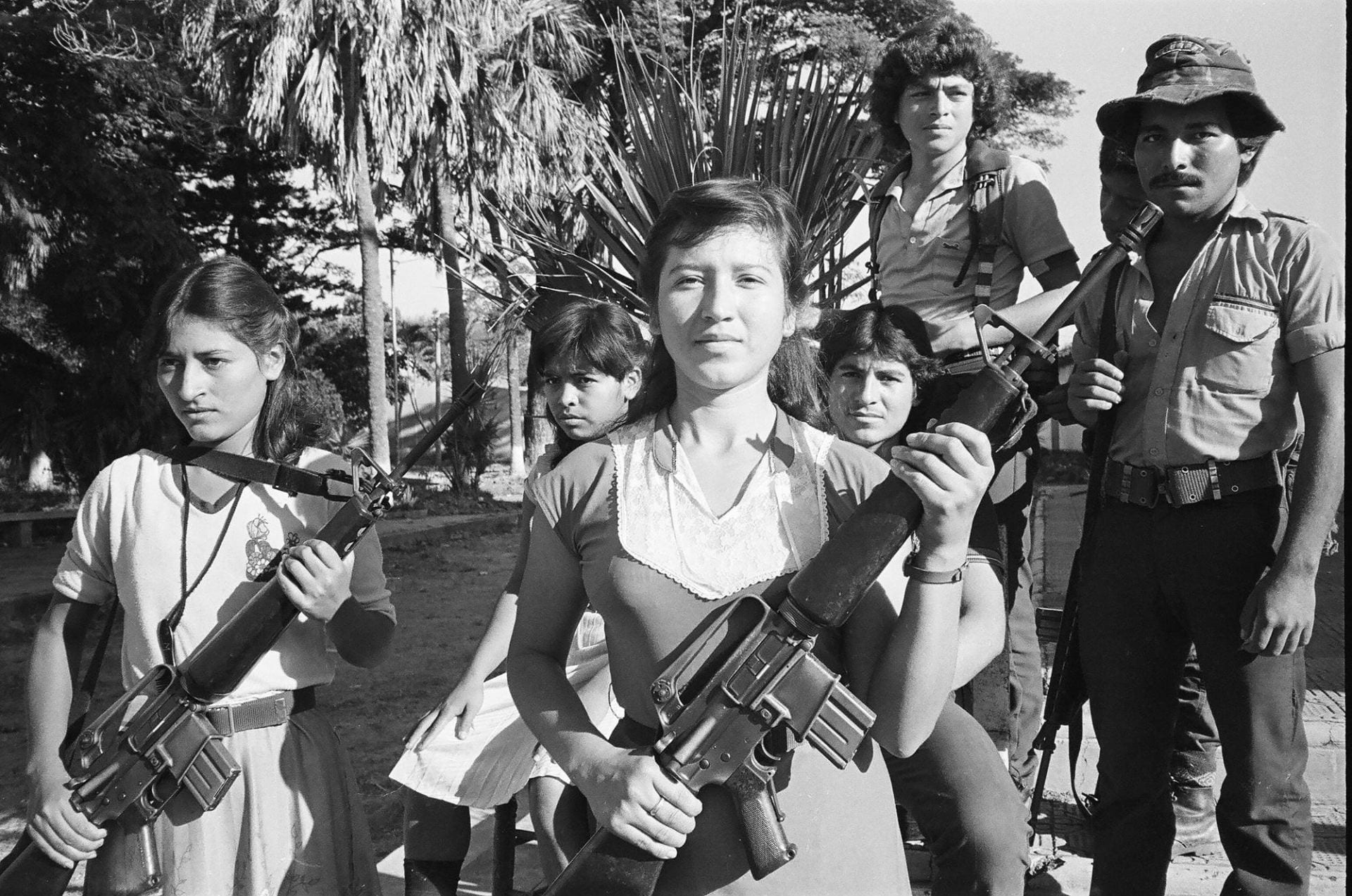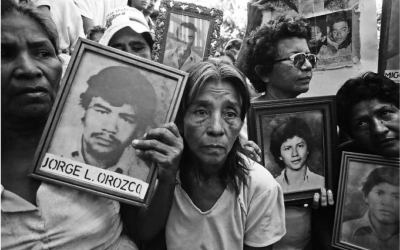Because They Were Taken Alive
Forced Disappearance in Latin America

Suzana Keniger Lisboa, Miike Valdemar Keniger and Luiz Eurico Tejera Lisboa in a 1969 family portrait. Photos by Gustavo Germano
In Guatemala City, a single garage light has been burning continuously for almost thirty years. The garage’s owner, a woman now in her nineties, cannot bring herself to turn it off.
On May 15, 1984, her son, Rubén Amílcar Farfán, left the house early as he usually did, headed for the university. But later that afternoon, friends of his rang the doorbell of the family’s house, anguished, to report the worst: witnesses had seen strangers force the young man, a literature student and union activist on his way home from work, into a waiting car and then drive away. Farfán, like many of his university contemporaries during this period of fierce state-sponsored violence, would never return home; he had joined the ranks of Latin America’s desaparecidos, or “disappeared.” Today, cold logic dictates that Farfán is almost certainly dead, but still his mother and sister keep the light on—so that when he comes home, they say, he will know that his family never gave up on him.
Over the course of the Cold War and beyond, well more than a hundred thousand Latin Americans were made to enter the netherworld of forced disappearance—some 40,000 in Guatemala, between 1,000 and 2,000 in Chile, as many as 30,000 in Argentina, 60,000 in Colombia, perhaps 6,000 in El Salvador, 15,000 in Peru, and, more recently, over 25,000 in Mexico. The numbers are necessarily imprecise because the crime itself is designed to produce uncertainty, leaving no corpses, no traces, no explanations, and hence, no accountability. Even the terminology that has evolved to describe it—the transformation of “to disappear” into an intransitive verb, as in to be disappeared or to disappear someone—is awkward and incomplete, communicating the involuntary nature of a person’s disappearance but nothing about that person’s destiny. It is a language that obscures as much as it reveals, as a desaparecido is neither quite dead nor alive, simultaneously present and absent. The Guatemalan sociologist Carlos Figueroa Ibarra describes the disappeared as “those who will always be nowhere”; for the Chilean theologian Mario I. Aguilar, they are “those who will never grow old,” men and women and children forever frozen in time at the precise moment of their vanishing.
As a systematic practice of calculated state repression in Latin America, forced disappearance was first deployed in Guatemala. The year was 1966, more than a decade after the CIA-sponsored ouster of the democratically elected president Jacobo Arbenz. By that year the country’s military and police, fortified by U.S. weapons and training, had embarked on a broad crusade, under the banner of anti-communism, to crush any and all forms of political dissent. As part of Operación Limpieza, or “Operation Cleanup,” state security forces rounded up at least thirty members of the country’s Communist party, tortured them, and dropped their bodies by plane into the Pacific Ocean. Some of their remains washed ashore, some didn’t.
As the Latin American Cold War heated up in the 1970s, the tactic was exported beyond Guatemala’s borders, as was a new epistolary form: the wrenching plea from a victim’s family, addressed to the state and often published in newspapers, for their loved one’s safe return. Families may not have known where a sister or son had been taken, but they knew that their governments bore the blame. Porque vivos se los llevaron, vivos los queremos—because they were taken alive, we want them back alive—became, for a generation of heartsick relatives, their central and consuming demand. It was too often unmet.
In Chile, General Augusto Pinochet cracked down on the opposition to his 1973 coup with a withering ferocity. Those trade unionists and students whom the regime tortured to death or summarily executed had their corpses spirited away, piled in remote mass graves in the Atacama Desert. There, their aging family members still walk the rocky plains in the thin air, searching for bone fragments, like ghosts.
In Argentina, the military junta that took power in 1976 elevated forced disappearance to a perverse art form. Expert manipulators of language to chilling effect, the generals thundered that desaparecidos were “absent forever.” They developed an elaborate process by which disappeared detainees were interrogated, tortured, bundled into airplanes, drugged into submission by licensed medical professionals, and dropped into the sea by the thousands. As one of the pilots of these so-called “death flights” later remembered, the sedated prisoners would plummet from the planes down into the dark waters of the Atlantic Ocean “like little ants.”
We know, from accounts of those detained and eventually released, a little about what many disappeared persons in Cold War Latin America endured in captivity—the interrogations, the electric shocks, the rapes. We know more about the impact those disappearances had on families, a powerful and multigenerational multiplier effect. Figueroa Ibarra chronicles family members’ recurring dreams and nightmares; their inability to mourn, since the disappeared could not be proven dead; the intensity of the social pressures on women whose partners had disappeared, especially if those women eventually found new partners; the guilt of resuming anything approaching “normal” life. State-sponsored disappearances were both political and psychological crimes, aimed to muzzle and shatter in order to tighten social control.
And yet, it was the singular horror of forced disappearance—what legal analysts Reed Brody and Felipe González call “perhaps the cruelest form of government abuse” for the torture it inflicts not only on detainees but on their emotional networks—that gave rise to some of the continent’s most iconic 20th-century social movements. These were groups, predominantly of women, who met each other in the course of their daily visits to the morgues in places like Buenos Aires and Guatemala City. (Such is the twisted nature of disappearance—it puts families in the grim position of actually hoping to find the physical remains of their kindred.)
The first such organization was the Mothers of the Plaza de Mayo, who in 1977 began marching in front of Argentina’s presidential palace, demanding the safe return of their disappeared children. For their efforts, which shook the foundations of the dictatorship’s legitimacy, several of the Mothers were themselves disappeared. A similar story unfolded in Guatemala, where the Mutual Support Group, founded in 1984, saw a number of its founding members disappeared or assassinated by state security forces. To speak out about a disappearance was a tremendous risk. As the Colombian peasant farmer Blanca Meneses Nieves recounts, when she sought help from local authorities—both elected and paramilitary—regarding the disappearance of her four daughters, the paramilitary commander instructed her to “disappear yourself if you don’t want us to kill you too.”
Almost worse than the original crimes were government functionaries’ official denials, phrased to deflect blame away from the state and onto the disappeared individual. The Argentine dictator Jorge Rafael Videla agreed that there were “missing persons” in Argentina, but he contended that “they have disappeared in order to live clandestinely and to dedicate themselves to subversion,” while one of his Guatemalan counterparts, military strongman Oscar Mejía Víctores, argued that many of the supposedly disappeared were “perhaps in some Communist country with some scholarship or in Havana, Cuba.” A common rejoinder to the anguished entreaties of wives, in particular, was to suggest that their husbands had only “disappeared” to take up with other women.
And then there was the matter of the disappeared children. In El Salvador, soldiers on military sweeps through guerrilla-controlled communities would snatch babies and toddlers—allegedly, in some cases, as war trophies. In Argentina, pregnant women detained in torture centers like the Navy School of Mechanics, or ESMA, were kept alive long enough to give birth, whereupon their infants were taken away and placed with army families in order to “eradicate the seed” of subversion. Organizations like the Grandmothers of the Plaza de Mayo, now a separate organization from the Mothers, and El Salvador’s Asociación Pro-Búsqueda, work today to locate these children—now adults—and, using DNA matching, to restore their birth identities.
Some countries have developed policy instruments in order to resolve the unresolvable and measure the unmeasurable. When the Argentine dictatorship fell, the new civilian government, headed by President Raúl Alfonsín, launched the National Commission on Disappeared Persons (CONADEP), the first of the hemisphere’s many truth commissions seeking to tally and account for the disappeared and dead. Years later, in attempting to create a reparations program for victims of the dictatorship, the national government crafted a new legal status for desaparecidos—“absent by forced disappearance”—that conceded the state’s responsibility for a person’s absence without presuming his or her death. (Reparations were another terrible practicality: did accepting reparations mean accepting that a brother or daughter had died?) As of 2013, the Argentine census will formally include desaparecidos as a population subcategory.
And yet the legal and logistical challenges posed by having a subset of citizens absent but officially considered alive continue to bedevil. Sebastián Piñera’s administration accidentally placed app-roximately a thousand individuals considered disappeared on the voter rolls for Chile’s upcoming presidential elections, proving, in the words of human rights activist Lorena Pizarro, “that this is a state that is not adequately confronting the issue of forced disappearance.” Also in Chile, a series of families had their desaparecidos’ remains returned to them during the 1990s—which, while a wrenching experience, at least brought closure—only to find after DNA testing that they had been given the wrong bones. State security archives contain many clues, including, potentially, confirmation of some desaparecidos’ deaths, information withheld from families even after dozens of habeas corpus requests. But in countries where armies remain powerful, winning access to the bureaucracy of state terror can be an uphill battle.
Largely as a result of the Latin American experience, international legal norms now accommodate and delineate the parameters of forced disappearance. The Organization of American States ratified the Inter-American Convention on the Forced Disappearance of Persons in 1994, and as of July 2002, the Rome Statute of the International Criminal Court stipulated that forced disappearance is a crime against humanity. The distinction is an important one, as it means that perpetrators can no longer claim protection under national amnesty laws, such as those passed in Guatemala and El Salvador when these countries’ civil wars concluded. And due to the indefatigable efforts of victims’ advocacy organizations, led by families like Farfán’s, prosecutions for the crime of forced disappearance are being mounted across the hemisphere, although these remain rare amid the staggering number of total cases.
But the law is, ultimately, an imperfect instrument for reckoning with the sublime horror of a person being erased from the earth by her government. Instead, disappearance has perhaps been best engaged with by art. The Colombian sculptor Doris Salcedo has long worked on the subject; her Atrabiliarios series uses shoes to represent the missing, because “whenever you see a shoe abandoned on the street, you ask yourself, ‘What happened here?’” Noemí Escandell’s Disappeared depicts an empty-armed Pietà wearing one of the kerchiefs of the Mothers of the Plaza de Mayo. The Argentine photographer Gustavo Germano, whose brother was disappeared, painstakingly recreates decades-old family photographs, retaking the image with only the surviving family members. (One of Germano’s photosets refigures a 1970s-era photo of a young, ecstatic couple dandling their baby beside a bed. In the recreated photo, that baby, now a striking woman in her twenties, stares alone at the camera; her parents are both desaparecidos.) And, mixing performance art with political theater, different chapters of the group HIJOS, representing the children of the disappeared, stage noisy guerrilla protests, or escraches, outside the homes of accused perpetrators.
While generations of Latin Americans transformed into activists by the disappearance of their family members fight on to clarify the crimes of the past, forced disappearance continues to be practiced today. Since 2006, when outright war began between the Mexican government and drug trafficking cartels, some 30,000 Mexicans have gone missing, and an estimated 70,000 more have been killed. The poet Javier Sicilia planned to march, alone and silently, from Cuernavaca to Mexico City in protest after his son’s murder; spontaneously, some 150,000 fellow citizens, appalled at this ongoing bloodbath, joined at his side. “I cannot write more poetry,” Sicilia told reporters after his journey. “Poetry no longer exists inside me.”
The geography of Latin America is now, irrevocably, a geography of forced disappearance, a landscape of deep and jagged chasms that can never be bridged. But there is another way to visualize an America, from Ciudad Juárez to the Tierra del Fuego, forever transfigured by enforced absence. Picture it as a distant satellite image at night, revealing a hemisphere dotted by thousands upon thousands of tiny lights—garage lights, burning bright with the impossible determination that because they were taken alive, alive they will return.
Kirsten Weld is Assistant Professor of History at Harvard University. Her book, Paper Cadavers: The Archives of Dictatorship in Guatemala, is forthcoming in March 2014.
Related Articles
A Search for Justice
In 2004, when I left Harvard and last saw you, I thought I would never learn the truth of what exactly happened to Carlos Horacio in the horrendous holocaust of the Palace of Justice in Bogotá. Yet fate was holding a tremendous surprise for my daughters and me, filled with…
Memory: Editor’s Letter
Editor's Letter Memory Irma Flaquer’s image as a 22-year-old Guatemalan reporter stares from the pages of a 1960 Time magazine, her eyes blackened by a government mob that didn’t like her feisty stance. She never gave up, fighting with her pen against the long...
A Search for Justice in El Salvador: One Legacy of Ignacio Martín-Baró
In the small rural town of Arcatao, Chalatenango, Rosa Rivera clung to the hope that one day she would find the remains of her disappeared mother and father and lay them to rest in peace. Others sought to exhume mass graves hoping to recover bodies of nearly 1,000 relatives massacred in the Río Sumpul. …




